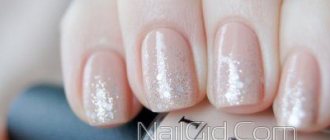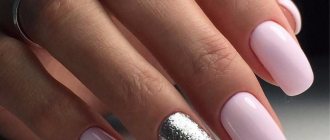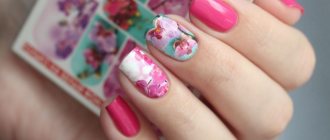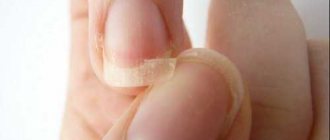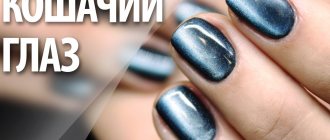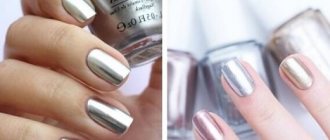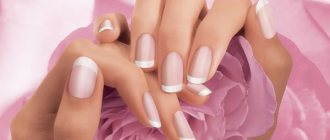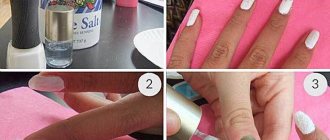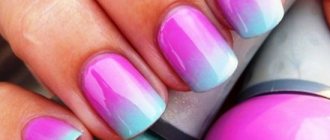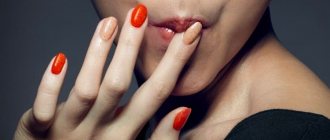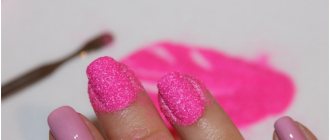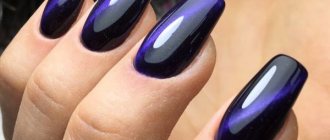Rubbings “Prism” and “Holography” are recognized as one of the most popular among this decor due to their incredible beauty in the finished image. The outwardly inexpressive pigment turns any classic polish or gel polish into a coating with the effect of an iridescent diamond. Since their appearance, designs using these decorative rubs have always been in demand in the price lists of practicing nail artists. What is the secret of their success, and what are these rubbings? We will tell you about this in detail today.
What is rubbing? "Holography" and "Prism": similarities and differences
What is a nail rub? Rubbing is a crushed micronized pigment. These can be either ultra-fine particles or larger microgranules, or decor in the form of mica flakes. Depending on the color, texture and size, they create a different visual effect, similar to popular coatings - chameleons, holographics, mother-of-pearls, microglitters. Rubs are produced in small jars (similar to other small decor for nail art). The choice of tool for applying (rubbing in) them - a fan brush, a sponge applicator, a silicone design brush, a master's latex gloves - also depends on what effect you want to achieve in the finished image.
Among the variety of existing products that love the bright sun or strong artificial light, fashionistas pay tribute to the beauty of holographics and prisms. Like no other, they create a special, festive mood. In summer - emphasizing sunny weather and creating a positive mood. And in winter - driving away the blues and bringing to mind thoughts of a pleasant series of holidays. What is the difference between these two beauties?
Incredibly popular prism (aka rubbing-mirage)
is a colored finely dispersed pigment. Its particles are so small that the coating with them produces an impressive deep 3D effect. The mesmerizing rainbow tints are visually similar in part to the veil of the northern lights, but most of all - to gasoline spilled on water. Particles of pigment rubbed into varnish or gel polish form a homogeneous, reflective, smooth canvas, without clearly visible shining particles.
Holographic
The rub
is an almost identical twin of the “mirage” pigment. It is very easy to confuse them in photographs, since under certain lighting and the angle of incidence of light, the “gasoline” beauty can also appear. The key difference between holographics is that their particles are larger. Even with perfect application (in one or two layers), the shine of individual grains of glitter is clearly visible. And scattered (fan) or linear holography, which is so popular at any time of the year, is visible.
Holographics give the effect of a diamond crushed into dust, and prisms are closer to the delicate beauty of pearls. Mirage rub is the choice of those girls who are not afraid to shine to the maximum. Modest holographic designs are an ideal compromise for the office, as their shimmer is more graceful and calmer. Due to their textural properties, mirages are better suited to varnish designs, since it is easier even for a beginner to rub them into almost set varnish. And the holographic glitter pigment is ideal for gel and gel polish, in the thickness of which it shimmers beautifully and does not rub off when worn.
Prismatic rainbow tints make the design original, stylish, and effective. When creating such images, it is important not to overdo it, but to demonstrate sophistication, a sense of proportion and taste. It will be much easier for you to do this if you know all the advantages and disadvantages of both types of rubs.
Varieties
The nail industry offers many options for rubbing. Each of them can create a special effect on your nails. The most popular and in demand are:
- Mirror. This is a pioneer. It was with her that the mass “promotion” of the powder into nail salons began. It comes in several shades: silver, lightly gilded, bronze. The particles are very small, thanks to which a dazzling shine is created throughout the nail.
- Holographic. It is also called a prism or rainbow. Creates an unusually festive design with an impressive deep three-dimensional pattern. A similar optical effect can be observed with gasoline spilled on a smooth surface.
- Pearl. It produces a gentle and feminine manicure. The powder imitates the pearlescent shimmer of natural pearls.
- Melange. Nail experts call her “sugar.” The particles are quite large. This decor is usually worn in the summer, coupled with bright shades of varnish. The nail becomes voluminous, creating the impression of a “soft” coating.
There are many more types of rubs: “northern lights”, “chameleon” (or “chameleon”), gold, diamond, etc. All of them are interesting and help to create an incredible design.
Designs with holographic rubbing and prism pigment: advantages and disadvantages
Decorative pigments “Prism” and “Holographic” are worth choosing and purchasing for many reasons. They will become worthy representatives of your decorative arsenal for self-manicure with varnishes and gel polishes both in the salon and at home.
Positive features of “sunny” decor:
- a design coated with a thick topcoat for varnish or gel polish is not afraid of color fading, changes in texture or dulling of the radiance of the rub. Your manicure is always impeccably beautiful and expressive;
- Although it seems that nails with holographic rubs are too simple and uncomplicated in design, nevertheless, you can create unique images using the rub as a canvas base. Painting, stamping, and even rubbing through a stencil will make your manicure expensive and stylish;
- both on short and long (gel or acrylic) nails, these types of rubbing are the easiest and fastest way to create a festive and fashionable look;
- Rainbow holographic rubs are ideal for summer manicures and pedicures. As a solo design, they will favorably emphasize the tan and well-groomed hands and legs;
- pigment in a “dust” texture is more convenient for beginners to work with rub-in designs. And the “holography” decor, due to its larger particles, can be used both for a mirror effect and as a product for painting nails (if you mix it in a top coat for polish or gel polish). The result is a very popular effect of “sparkling volumetric tears”;
- “Prism” and “Holography” rubs are very easy to apply, remove, and correct in the process of creating a manicure. They are very economical and affordable;
- These decorative elements can be mixed with other shades (for example, creating rub-prism duets from several halftones). This will allow you to create unique, almost designer color schemes on any substrate color.
Negative points of iridescent rubs:
- “solar” pigments attract maximum attention to the nails. This means your manicure should be impeccable: well-groomed cuticles, soft and delicate skin of the hands and feet;
- The most durable and chic rub-in manicure is in gel and shellac versions. This means you will have to fork out for a lamp to cure the design;
- the effect of holography and overflow of gasoline is most attractive when distributed as evenly as possible. This is more difficult to do on nail polish than on a gel polish top coat. This means you will need a lot of practice;
- Manufacturers of shining pigments often call your creations synonyms (rubbed “holographic prism”) or, due to the similarity of the effect, call holographics a mirage rub and vice versa. Which makes it difficult to create an image, since different types of rubbing require their own topcoats for gel polish (with or without stickiness). It is because of this confusion that the design often does not turn out as beautiful as it is intended to be. And beginners are unreasonably disappointed in rubbings in general.
So how can you quickly, correctly and without complications create a chic and unforgettable prismatic-holographic nail-look?
Application methods
Experts say that the rub is a non-fragile material, making it easy to apply at home. But before you practice, first you need to familiarize yourself with some subtleties...
Features of using the rub
In order for your manicure to turn out flawless, you must adhere to several important rules. Professionals recommend using the following tips:
- The smooth and shimmering shine of the rub depends on your nail plate. It's no secret that many women's nails are uneven: somewhere there are bulges, somewhere there are dimples. Therefore, it is necessary to level the surface using gel. This is the only way a shining manicure will look perfect. Otherwise, fine powder will highlight all imperfections.
- Properly selected varnish will help in creating your masterpiece. Here it is important to check the expiration date of the dye and its consistency. It should not be too thick or runny. Color doesn't matter.
- You are allowed to rub in dust with your fingertips, a sponge, or an eyeshadow brush. It all depends on your preferences. Multi-layer top fixation. This is the final touch in creating a manicure. This is the product that will help the rub last a long time.
This is interesting: Did you know that American celebrity nail artist Jenna Hipp came up with an original idea - to make eyeshadow rubs? Yes, yes, she used this technique when Miley Cyrus and Jennifer Lawrence came to her for a manicure. The old decorative product did its job perfectly!
For varnish coating
Don't have time to go to a nail specialist? Do you need to look chic and with well-groomed hands this evening? A pearl rub (if you don’t have it, then use eye shadow) on regular polish will help make your nails unmatched. This is a short procedure, taking only about 30 minutes.
You will need:
- pearl powder;
- any varnish;
- manicure set;
- fluffy brush;
- glossy top.
Algorithm of actions:
- Do a classic manicure: give your nails the desired shape, remove cuticles, and thoroughly polish the nail surface.
- Apply the varnish you like and let it dry a little (but not completely, so that a sticky layer remains).
- Take pearl powder and apply it thickly on your nail. Don’t be afraid to go beyond the surface of the nail; the rub should cover both the cuticle and part of the finger (this is the only way to achieve a high-quality design).
- Gently rub the particles in a circular motion, but do not overdo it: you can easily damage the varnish layer.
- Use a brush to brush off any remaining powder.
- Using a glossy topcoat, fix the rubbing. Apply multiple coats for stronger adhesion.
- Dry the nail and move on to the next finger.
Experts say that it is not necessary to apply fine sand to all nails. You can distribute the rub over a full nail, one nail, two, etc. It all depends on your imagination and taste preferences.
For gel coating
Some girls believe that only nail technicians can apply rubbing onto gel polish. However, it is not. Even a beginner can master this technique. And you can be sure of this!
You will need:
- manicure set;
- Ultraviolet lamp;
- leveling gel;
- dehydrator;
- strengthening base;
- any gel polish;
- rubbing (at your discretion);
- glossy top.
Step by step process:
- Do a classic manicure: give your nails the desired shape, polish the surface, trim the cuticles.
- Apply a dehydrator to your nails.
- Smooth the surface of the nail with gel and dry in an ultraviolet lamp for 1 minute.
- Apply your favorite shade of gel polish onto two layers. Hold your hand in the UV lamp for 30-40 seconds.
- Distribute the glossy top coat over the surface, do not forget to seal the end of the nail (this will preserve your manicure for a long time).
- Using circular motions, apply a thick layer of rub. Try to distribute the powder carefully, without pressing too hard on the nail.
- Carefully remove shiny particles from the skin (you can use a brush or an orange stick).
- Apply glossy top coat to your nails twice and dry in a lamp for two minutes.
- Remove the sticky layer with an alcohol wipe.
That's all! Decorating the marigolds is finished.
For clarity, I suggest you watch the video in which the master explains in detail how to apply the rub on gel polish.
Features of iridescent manicure: how to rub “prism” and “holographic” into polish and gel polish.
Creating a monocolor look on all nails or using rubs as an accent on 1-2 fingers differs significantly when working with polishes and gel polishes. If for the usual classic varnishes there is no difference in the application of holographic and prismatic pigments, then with gel varnishes there are important nuances for each type of this spectacular decor. Let's look at everything in detail.
Rubbing-prism and rubbing-holography for nails on regular classic varnish
How to use holographic rub and prism nail rub on classic nail polish? Let's look at the step-by-step technology for creating an image:
- We carefully prepare the nail and treat the adjacent skin (polish the nails with a soft buff and remove the cuticle and pterygium with a remover or Fraser);
- We shape our nails with a nail file, adjusting the length and shape. Don’t forget to polish the free edge as well to prevent delamination;
- We apply a base (for problematic nails - healing or strengthening);
- Apply one or two coats of your chosen shade of cream polish to your nails. Dry the coating until the varnish is no longer smeared, but is still slightly soft;
- For varnish, work with a soft applicator, lightly rubbing the mixture in the direction from the cuticle to the free edge of the nail;
- Secure the result with a thick top. If desired, use a varnish dryer. Without topcoat, on day 2-3 the glitter of the rub will thin out due to friction on various surfaces;
- The amazing design of your dreams is ready!
As for the technology of using mirage and holography on shellac and gel polish, each type of decor has its own nuances. Let's look at them one by one.
How to rub prism pigment into gel polish:
- We perform classic trimmed or untrimmed nail preparation: remove the softened cuticle with an orange stick or manicure scissors, file the nails and shape them to the desired length. Remove the light layer of the top keratin layer with a light buff;
- If you carry out the design immediately after removing the previous image, then you skip the buff polishing stage. We degrease and disinfect the nails, apply primer, bonder, and base. For severe aesthetic problems of nails, we use a base with healing and strengthening properties. For brittle and thin nails, you should prefer a rubber base;
- Dry the base in an LED lamp (2 minutes or 30 seconds, respectively);
- We paint the nails with gel polish in 1-2 layers, drying each one thoroughly in a lamp;
- We cover the finished color base with a non-sticky topcoat, which is also baked in a lamp in accordance with the manufacturer’s recommendations. The exception is some rubbing prisms from Tnl. They need to be rubbed onto the sticky top;
- Using soft, smooth, polishing movements, apply the rub using the tool of your choice. We try to carefully work on the area of the cuticle and side ridges. The direction of rubbing is from the lunula (semicircle near the cuticle) to the end of the nail;
- We continue polishing by rubbing until a homogeneous and uniform shine is obtained. Using a fan brush, carefully brush the rub off the skin and cuticles, working through the nail sinuses as well. Apply the top finish in two thin layers: with stickiness, if you want to further decorate the resulting image. And without a sticky layer, if you want to enjoy a shining solo manicure;
- Let's contemplate the incredibly attractive beautiful space design!
Rubbed glitter “Holography” on gel polish.
- We repeat steps 1-4 from the previous master class;
- Apply a non-sticky topcoat to the colored coating and dry it in a UV lamp for 2 minutes. In case you don’t have such a top on hand, apply the finish with a sticky layer, dry and remove the dispersion layer with a special liquid and a lint-free cloth;
- Using a brush or applicator without strong pressure, gradually and smoothly rub in the holographic rub, carefully crushing all the grains of pigment into an even layer;
- We remove excess holographic powder and re-coat the design with finish. We select the type of top depending on the desire/unwillingness to further decorate the nails;
- As in the case of varnish design, manicure with a prism, do not forget to apply each layer of coating, sealing the free edge for greater durability of the image;
- A breathtaking and stylish “rainbow” look is ready!
When working with rubs in general, and with mirage and holographic in particular, it is worth keeping in mind some of the features of this manicure in order to complete the design correctly and without errors. Let's study them!
Tips for use
When rubbing is used to obtain a mirror surface, the application is almost the same, but still has the difference that the product must be rubbed not into the sticky coating, but into the top or non-sticky varnish. Particularly small particles of powder will be perfectly fixed on a smooth surface, creating the necessary mirror effect. Afterwards, the nails are covered with a finishing transparent varnish.
The fact that the rub has some transparency should be taken into account when choosing the color of the base varnish.
The rub can be applied not only to the colored base, but also to the top coat. In this case, the manicure will be somewhat lighter, but will not lose its shine. How to use grout should be decided immediately when thinking about your nail design.
When doing a manicure with gel polish, you need to carefully ensure that it is applied perfectly evenly. There should be no lumps or bubbles in the layer. If you do a manicure with rubbing, if they are present, it will look extremely unattractive. To prevent unevenness, use a self-leveling agent.
You should not rub with great force when adding new glitter, as this will lead to the top layer being torn off by the resulting new one. Rub the pigment in with light pressure so that the glitter sticks to the coating, but does not peel off from it.
On a dark layer of the base varnish, the pigment can show through, and therefore it is recommended to apply the rub in 2 layers. This will prevent the appearance of bald spots on the nail plates.
After applying the rub, before applying the top coat, it is necessary to process the nail plate at the cut site with a file. This will remove any glitter that has fallen onto the end and will allow the nail plate to be fully sealed when applying the top coat.
If you do not brush along the edge of the nail with a top coat, then very soon the varnish will begin to peel off from the end of the nail.
Stylists recommend using chrome manicure only for holidays, when shine is appropriate and necessary. In everyday life, a chrome manicure looks somewhat strange and tasteless. If you still want to add a shiny surface to your nails, then use the rub to create a chrome effect on only 1-2 nails - no more. In this case, they will turn out to be a piquant accent in the image, and not its main component, which does not look good with a business suit.
Types of topcoats for gel polish
Now there are quite a few types of nail toppers:
- With a sticky layer
- No sticky layer
- Universal
- Matte
- Rubber
- With shimmer
- With cat eye effect
- With UV filters
- Hypoallergenic
- Camouflage
- Holographic
- Thermo tops
Using a top, you can give your manicure various effects or create an interesting design. You can create a glossy or matte finish. You can add glitter or a holographic effect to your manicure. Decorate the design with rhinestones or stickers.
In addition, if the top is chosen correctly, then your manicure, on natural nails or on nails after extensions, will last you a long time without cracks or chips.
The choice of top will depend on the problems that you want to solve with its help. There are a lot of options, now I’ll tell you about all types of top coatings in order. And we’ll start with the types of top coats for gel polish.
Work on mistakes
It happens that the rub does not stick to the nails and immediately peels off. This indicates that the application technique was violated. To avoid this, I suggest you familiarize yourself with common mistakes that even pros make:
- Wrong size of fine particles. The rubbing can be different - from small “sugar” grains to weightless dust. Therefore, it is necessary to choose the right size. In this case, it matters: large particles do not attach well to the nail surface, and very small ones take a long time to dry.
- Poor choice of gel polish. If this product has a poor-quality sticky layer, then the fine powder is unlikely to adhere to it. It will immediately fly off and sadden the owner of a shining manicure.
- Before applying a glossy base or topcoat, the gel polish must dry thoroughly. Otherwise, the powder will cling to the brush or sponge when applying the “top”. And this will lead to the appearance of bald spots.
These are the three most common mistakes, so be sure to pay attention to them. And then your hands will look great.
How to use nail top
Basic rules for applying and using gel polish top:
- The top is applied strictly after gel polish.
- Before using the top, to stir it, you need to take the bottle and gently roll it between your palms for 1 minute. Under no circumstances should the bottle of top coat be shaken or shaken, as this may cause the top coat to bubble when applied to the nails.
- All topcoats are applied from the cuticle to the edge of the nail plate with light movements, holding the brush parallel to the nail. Don't put too much pressure on the brush. Then the top will lie beautifully and evenly.
- Be sure to seal the end and sides of your nail when applying top coat, this will help make your manicure last longer.
- The drying time for the top in UV, hybrid or LED lamps is indicated by the manufacturer on the bottle with the top. Always follow this time exactly. The top should not be under-dried, otherwise it will release toxic substances that can enter the stomach. And if the topcoat is too dry, it can lead to cracks and chips in your manicure.
If you want to give your nails a well-groomed look and protect them from harmful influences, but you don’t like colored polish or the situation requires you to follow a certain etiquette, you can apply the base directly to the top. It will be minimalistic and stylish.
Basic rules for using and applying top coat for regular nail polish:
- The top is applied after the colored varnish has completely dried, as the last layer.
- You don't need to shake it before use, otherwise it may leave bubbles on your manicure.
- You can coat your nails with top coat 1 or 2 times, if desired, the main thing is to thoroughly dry each layer in the open air.
Video on how to rub glitter on gel polish
If you have recently come across nail rubs and want to see how to do everything and what the effect will be, then this video is just for you. You can use other colors of gel polishes and the rubs themselves for the base ; you don’t have to completely follow the master in the video. The video simply clearly shows how to properly rub in, but otherwise follow your imagination!
We hope that we were able to help you understand what rubs are and how to make them. We look forward to your feedback and questions about this type of manicure!
What is a nail rub?
The rub (pigment) is a shiny powder with a soft structure. This is a fine polyester dust that forms a mirror-like smooth coating on the nails. The product is made from various materials, which determines the color and intensity of the shine of the manicure. The decorative coating is resistant to ultraviolet radiation, moisture and other external factors. Making a mirror, pearl or holographic manicure for yourself will not be difficult, which is the main advantage of the new product. The technology for using powder involves the presence of a coating layer on the nail plate to fix it. The following are used as a base: • gel polish; • acrylic; • top coating.
A convenient compact box with pigment will not take up much space in your cosmetic bag. From the offered assortment, you can select many different options and use them separately or in combination with each other, creating an exclusive nail design. It is worth considering that the tone of the varnish layer determines the shade of the manicure.
Rubbed nails: types of material
Inspired by women's increased attention to mirror rubbing, manufacturers have released many types of powder. It differs in size, color, degree of shine.
Specialists in salons often use the following types of pigment: • multi-colored powder (melange) to highlight several nails on the hand to make an accent; • mirror powder applied using a sponge; • dry glitter.
Among the main types of rubbing, the most popular are: • mirror; • pearl; • holographic; • silver; • gold.
For a detailed overview of all types of rubbing, as well as the most current designs, see the next publication!
How can you replace nail topcoat?
When performing manicures with gel polish, masters do not recommend replacing the top coat with some other product. Since this can affect the durability of the coating and its quality.
For example, if you cover gel polish with a base instead of a top coat, then when you remove the sticky layer, the surface may become cloudy and your manicure will be ruined. In addition, the base is not intended to protect the manicure from damage or fading in the sun. Therefore, the duration of wear can be significantly reduced.
There is also an option to replace the topcoat with a topcoat that is used to fix regular nail polish. This option is possible. Please note that you do not need to dry this top in a lamp; it is simply air dried. But, you must understand that the durability of such a coating will not be long.
But replacing the top coat for regular polish with a top coat for gel polish is definitely not worth it. Since this top coat will remove regular polish and your manicure will be ruined.
Of course, these options can be used in emergency situations. For example, when the top is unexpectedly lost, dried out or runs out. But, it is better to use a gel polish top coat as a finishing coat, or in order not to bother with different jars, you can simply purchase a single-phase system.
Below I’ll tell you about the 7 best top coats for nails. And in this video you can see which budget top to choose for a beginner for manicure with gel polish.
